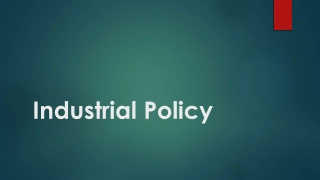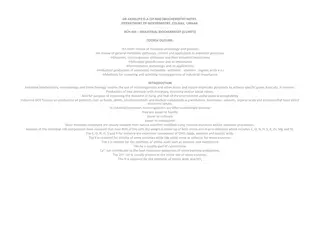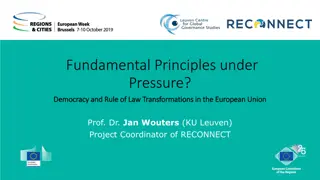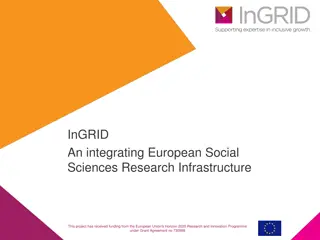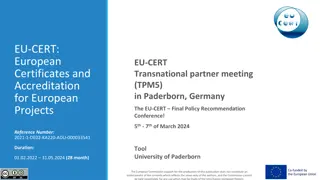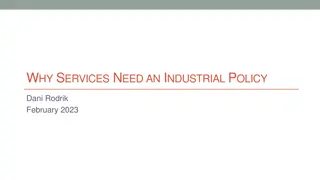European Industrial Policy
The evolution of European industrial policy from ancient times to modern approaches in 2014, focusing on key milestones and pillars such as investment in innovation, easy access to key inputs for firms, maximizing the Internal Market potential, internationalization of EU firms, and creating a business-friendly environment.
Download Presentation

Please find below an Image/Link to download the presentation.
The content on the website is provided AS IS for your information and personal use only. It may not be sold, licensed, or shared on other websites without obtaining consent from the author.If you encounter any issues during the download, it is possible that the publisher has removed the file from their server.
You are allowed to download the files provided on this website for personal or commercial use, subject to the condition that they are used lawfully. All files are the property of their respective owners.
The content on the website is provided AS IS for your information and personal use only. It may not be sold, licensed, or shared on other websites without obtaining consent from the author.
E N D
Presentation Transcript
European Industrial Policy International Conference on Manufacturing Led Growth for Employment and Equality Johannesburg 20 May 2014 Francisco CABALLERO
Ancient European Industry Policy (before 1986) 1960s and 70s - Active role of the public sector in the economy (ENI) 1970s Restructuring of mature sectors 1985 Single Market Act and the Launching of the Single Market. An example of industrial policy success - GSM
European Industrial Policy 2004 BETTER EU LAW-MAKING MULTI-POLICY APPROACH
European Industrial Policy in 2014 I. Why an industrial policy? II. What kind of industrial policy? What to do? Who should do it? III.How should it be implemented?
I. Why an industrial policy? Increasing competitiveness is an urgent need for the EU In the long term For the recovery The consequences of losing a strong competitiveness are a matter of concern: Industry matters ! If there is no industrial policy there is an industrial policy but is that the best industrial policy.
II. What kind of industrial policy? A consolidated industrial policy for Europe? An industrial system in the EU A sectoral or a horizontal industrial policy? Activities Focused on manufacturing? No, services too The importance of sustainability Not a one off exercise, but continuity in the rolling out of IP, stability and predictability
The pillars of EU industrial policy 1. Investment in innovation 2. Easy access to key inputs to firms, SMEs in particular 3. Maximise the potential of the Internal Market 4. Internationalisation of EU firms 5. Provide a business friendly environment
1. Investment in innovation Horizon programme Task forces Advanced manufacturing technologies Clean vehicles Bio-based technologies Key enabling technologies Smart grids Sustainable construction
2. Easy access to production inputs Access to finance Access to raw materials Access to energy Energy Skills
3. Maximize EU internal market's potential Finalize transport and energy networks Market surveillance and product safety Standards to accelerate innovation Student and workers' mobility for greater skills Internal market for services Digital agenda
4. Internationalisation of EU firms Exports: European success story to be continued Facilitate the integration of EU firms in global value chains Ensure access to global markets
5. Provide a business friendly environment Potential of clusters and smart specialisation Updated Small Business Act Growth-friendly public administration Regulatory fitness and performance programme Cumulative cost assessments
III. How to implement EU industrial policy? 1. Improved policy making (a) Mainstreaming of competitiveness (b) Building a partnership with Member States and Regions 2. Credible commitment: Use our financial resources
a) Improved policy making Mainstreaming of competitiveness Already underway inside the Commission. Ex: Tools: Development of suitable instruments: Competitiveness proofing, fitness checks Policies: State aid modernisation - Cohesion policy More work remains to be done: Systematic assessment of competitiveness impacts across policy areas and improving the analysis and knowledge base (e.g. competitiveness observatory) Upstream co-operation and impact assessments
b) Improved policy making: Building a partnership with Member States and Regions Co-ordinated approach needed between EU, MSs and regions: ownership and regular monitoring of industrial policy needed from COMPET Council Assessing the efficiency of mechanisms to ensure that decision-making and implementation of industrial policy at regional, national and EU level is mutually reinforcing
2. Credible commitment: Use our financial resources 2.3 billion COSME programme to support entrepreneurship > 100 billion of European Structural and Investment Funds (ESIF) available for regions to finance investments in industrial competitiveness 80 billion of the Horizon 2020 Programme available for financing the commercialisation of research
European Industrial Policy 2014 Priorities o Reindustrialisation o Upgrading EU industry in the context of the new industrial technologies o Integrating EU firms in the global value chains Drivers o The impact of the financial crisis o Increasingly tough competition from emerging countries and advanced economies o Fourth industrial revolution o Energy market issues Axes of action: Five pillars Implementation
Conclusions o - Creating the right state of mind: a positive sum game that is credible (*) o - Identify clearly what you can do and what you cannot do and be realistic (**) o - IMPLEMENTATION (***)
Europe is no longer a world "maker" (Manufacturing contribution to GVA)
Closing up the output gap Euro area output gap (% of potential GDP) (source: EC, OECD and IMF)
Low growth forecasts: Accelerating growth is a top priority GDP Growth forecasts for the Euro Area and the EU (source: IMF, OECD and EC) EU GDP growth Source: Eurostat
The consequences of de- industrialisation would be serious Leading in innovation Leading EU s exports 100% 90% 80% 70% 60% 50% 40% 30% Share of manufacturing on value added and privateR&D expenditure 20% 10% Source: Industrial Competitiveness Report (2013) 0% 2000 2001 2002 2003 2004 2005 2006 2007 2008 2009 2010 2011 2012 Industry Others Share of manufacturing on EU-27 Exports Source: Eurostat
Priorities of Commission response 1. Mainstream industrial competitiveness 2. Use financial resources at our disposal 3. Provide more business friendly environment 4. Ease access to production inputs 5. Maximise potential of EU's internal market 6. Internationalise 7. Facilitate mobility via education and training


